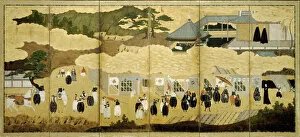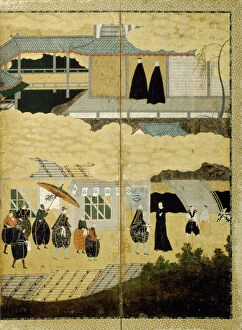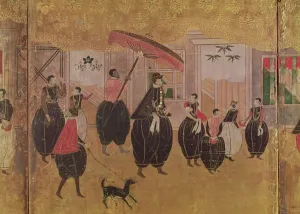Namban Collection
"Namban: The Fusion of Cultures in 16th-17th Century Japan" The arrival of a Portuguese ship marked the beginning of an extraordinary era in Japanese history
All Professionally Made to Order for Quick Shipping
"Namban: The Fusion of Cultures in 16th-17th Century Japan" The arrival of a Portuguese ship marked the beginning of an extraordinary era in Japanese history. Nanban screens, crafted around 1600 by an anonymous artist, depict this pivotal moment when European influence entered the Land of the Rising Sun. These intricate screens showcase not only the grandeur of Portuguese vessels but also reveal glimpses into the lives of Japanese Christians. Intriguing artifacts from this period include a small Namban box and cover, adorned with exquisite lacquer work. Its delicate craftsmanship reflects the cultural exchange between East and West during this time. Similarly, a Momoyama Period Christian folding missal stand showcases stunning lacquer artistry while serving as a testament to Christianity's growing presence in Japan. Namban Christian portable shrines were designed specifically to house religious statuettes cherished by devout followers. These intricately designed shrines served as tangible symbols of faith amidst changing times. Another example is an export pipe holder from the late 17th century, displaying exquisite lacquer techniques that highlight Japan's mastery in adapting foreign influences. Two rare large square tokkuri bottles from the Momoyama Period further exemplify how artistic traditions merged during this transformative era. Their lacquered surfaces tell stories through vibrant colors and intricate patterns—a testament to both Japanese craftsmanship and openness towards new ideas. Within these historical artworks lies evidence of Japanese Christians depicted on Nanban screens—an acknowledgment that religion played a significant role during this period characterized by cultural exchange and exploration. "The Arrival of the Portuguese in Japan, " captured on folding screens, offers us insight into how these encounters shaped society at its core. As we delve deeper into these masterpieces created centuries ago by anonymous artists, we witness firsthand how Namban became more than just a label—it became a symbol for embracing diversity and celebrating shared humanity across continents.















